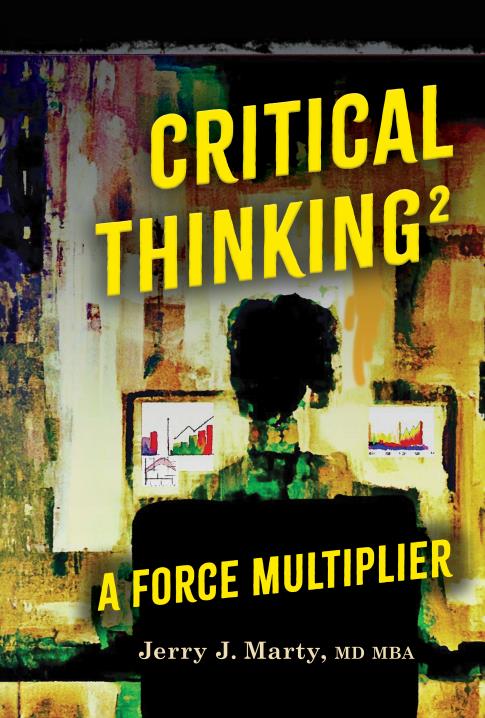
LEADERSHIP LEGACY
February 24, 2024Critical Thinking² – A Force Multiplier
By: Jerry Marty MD MBA“Critical Thinking² – A Force Multiplier” encompasses problem identification and analysis, the use of reasoning and logic, and the employment of methodological tools of discernment. Confirmation and cognitive biases, heuristic thinking, logical fallacies, and dissembling all represent obstacles to avoid on the way to the goal of problem analysis and decision-making. Business models predominate throughout, as do everyday life lessons. Illustrative examples are also taken from the author’s unique vantage point and medical perspective, particularly examples of establishing the pathological diagnoses of cancer.
Author: Jerry Marty MD MBA
Gener: BUSINESS & ECONOMICS
SubGenre: Decision-Making & Problem Solving
Language: English
Pages: 326
Overview
“Critical Thinking² – A Force Multiplier” encompasses problem identification and analysis, the use of reasoning and logic, and the employment of methodological tools of discernment. Confirmation and cognitive biases, heuristic thinking, logical fallacies, and dissembling all represent obstacles to avoid on the way to the goal of problem analysis and decision-making. Business models predominate throughout, as do everyday life lessons. Illustrative examples are also taken from the author’s unique vantage point and medical perspective, particularly examples of establishing the pathological diagnoses of cancer.
Description
The Author provides a summary of the definition, principles, and challenges related to Critical Thinking2 – A Force Multiplier. In business and management, one faces many challenges, especially uncertainty, lack of information, unpredictability, and ambiguity. Problems that need systematic analysis will invariably arise. The fundamental proposition of this book is that “Critical Thinking2” lies at the interface of problem analysis and decision-making. Stepwise methodical problem analysis leads to decisive decision-making. This process precedes actual problem analysis and decision-making. Incisive comments about competence versus incompetence and the Dunning-Kruger effect (“If you don’t know what you don’t know,” and the “confidence gap”) are made in Chapter One, along with an in-depth discussion of intellectual curiosity, deliberation, and decision-making. Chapter Two covers the more common methodologies and techniques utilized in problem analysis, such as the Delphi technique; Strengths, Weaknesses, Opportunities, and Threats; the Cause and Effect (Fishbone or Ishikawa) diagram; Root Cause Analysis; Weighted Decision Matrix; Cost-Benefit Analysis; Breakeven Analysis; Probability Analysis; Sensitivity Analysis; Pareto Analysis; Analytic Hierarchy Process; Statistical Modeling (especially use of Linear Regression); Bayesian Analysis; Machine Learning; and Artificial Intelligence. An Introduction and overview to Statistics, especially the discussion of sample size, sample bias, statistical and practical significance, Linear Regression, the “Null” Hypothesis, the T-test, and F-test are discussed in Chapter Three. The distinction between “truths” and “facts,” ending with an explanation of the contrasting correspondence and performance theories of “truth,” is delved into in Chapter Four. The book emphasizes information, data, and “facts” as distinguished from “truth,” but also examines misinformation, disinformation, and gaslighting. The Decision-Making process is an endpoint.
About The Author
Dr. Jerry J. Marty received his Medical degree (MD) in 1976 from Wayne State University School of Medicine, Detroit, Michigan, Thereafter, he completed six postgraduate (PG) years of training at: Montefiore Hospital and Medical Center/Albert Einstein College of Medicine (PG Year one), Strong Memorial Hospital/University of Rochester Medical Center, Rochester, New York (PG Years two to three, and PG Years five to six), and, completed an additional year in straight Internal Medicine at Saint Joseph’s University Hospital – VA Medical Center/Creighton University School of Medicine, Omaha, Nebraska (PG Year four). A Visiting Fellowship in Clinical Cytology and Fine Needle Aspiration (FNA) was undertaken during the fall of 1989 under the world-renowned Dr. Torsten Lowhagen at the Karolinska Hospital and Institute, Stockholm, Sweden. The author is Board-certified in Anatomic, Clinical, and Cyto-Pathology with a sub-specialization in Fine Needle Aspiration (FNA) Cytology. He has authored several publications in peer-reviewed medical journals and two separate Book Chapters in his field of expertise, specifically in Cytopathology and Fine Needle Aspiration (FNA) Cytology. Among his earlier responsibilities, Dr. Marty had teaching positions at Case Western Reserve University in Cleveland, Ohio, and, later, at the Northeastern Ohio Universities College of Medicine and Pharmacy (now Northeast Ohio University College), Rootstown, Ohio. A Master Business Administration (MBA) degree at George Washington University, School of Business (GWSB), Washington, D.C., was conferred on May 17, 2009. Dr. Marty’s most recent professional position until 2016 was as Chairman of Pathology and Medical Director of Laboratories at MedStar Franklin Square Medical Center (MFSMC), a three-hundred and seventy-eight-bed Joint Commission-accredited hospital facility in Baltimore, Maryland. He is based in the United States and, when not working, enjoys travel, photography, and Chess.
Q & A
Ask a question
Your question will be answered by a store representative or other customers.
Thank you for the question!
Your question has been received and will be answered soon. Please do not submit the same question again.
Error
An error occurred when saving your question. Please report it to the website administrator. Additional information:
Add an answer
Thank you for the answer!
Your answer has been received and will be published soon. Please do not submit the same answer again.
Error
An error occurred when saving your answer. Please report it to the website administrator. Additional information:




Reviews
There are no reviews yet